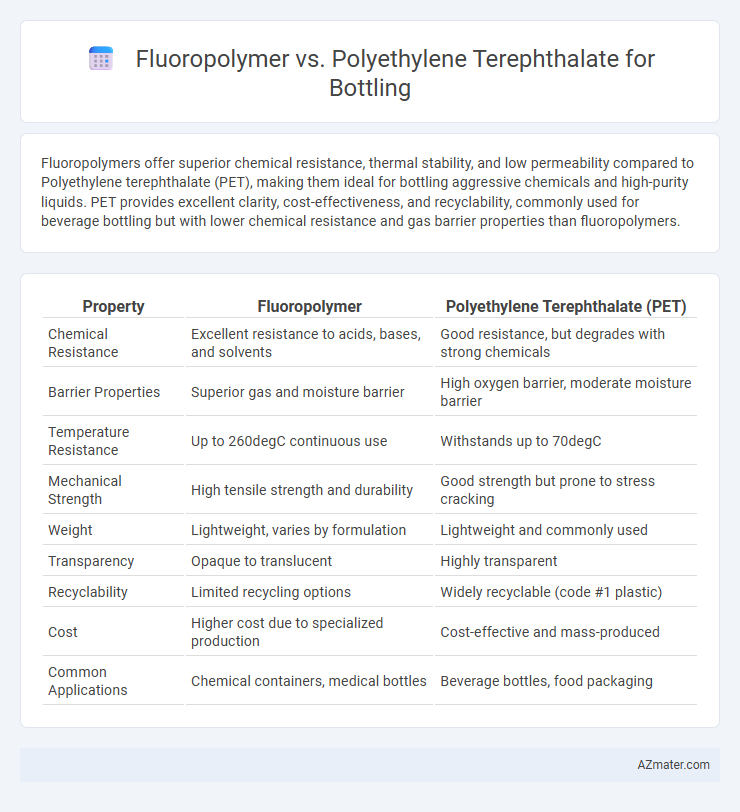Fluoropolymers offer superior chemical resistance, thermal stability, and low permeability compared to Polyethylene terephthalate (PET), making them ideal for bottling aggressive chemicals and high-purity liquids. PET provides excellent clarity, cost-effectiveness, and recyclability, commonly used for beverage bottling but with lower chemical resistance and gas barrier properties than fluoropolymers.
Table of Comparison
| Property | Fluoropolymer | Polyethylene Terephthalate (PET) |
|---|---|---|
| Chemical Resistance | Excellent resistance to acids, bases, and solvents | Good resistance, but degrades with strong chemicals |
| Barrier Properties | Superior gas and moisture barrier | High oxygen barrier, moderate moisture barrier |
| Temperature Resistance | Up to 260degC continuous use | Withstands up to 70degC |
| Mechanical Strength | High tensile strength and durability | Good strength but prone to stress cracking |
| Weight | Lightweight, varies by formulation | Lightweight and commonly used |
| Transparency | Opaque to translucent | Highly transparent |
| Recyclability | Limited recycling options | Widely recyclable (code #1 plastic) |
| Cost | Higher cost due to specialized production | Cost-effective and mass-produced |
| Common Applications | Chemical containers, medical bottles | Beverage bottles, food packaging |
Introduction to Fluoropolymer and Polyethylene Terephthalate
Fluoropolymers, known for their exceptional chemical resistance, low surface energy, and high thermal stability, are widely used in advanced bottling applications requiring durability and purity. Polyethylene terephthalate (PET) is a popular thermoplastic polyester with excellent clarity, strength, and gas barrier properties, making it ideal for food and beverage packaging. Comparing fluoropolymer's superior chemical inertness to PET's cost-effectiveness and recyclability helps determine the best choice for specific bottling needs.
Chemical Structure and Properties Comparison
Fluoropolymers, characterized by strong carbon-fluorine bonds, offer exceptional chemical resistance, thermal stability, and low surface energy, making them ideal for aggressive or reactive liquids in bottling applications. Polyethylene terephthalate (PET), a polyester formed from terephthalic acid and ethylene glycol, provides excellent clarity, mechanical strength, and good barrier properties to gases but is less resistant to solvents and high temperatures compared to fluoropolymers. The highly inert and hydrophobic nature of fluoropolymers contrasts with PET's semi-crystalline structure, influencing durability, chemical inertness, and suitability for various beverage bottling environments.
Barrier Performance: Gas and Moisture Resistance
Fluoropolymers exhibit superior barrier performance against gases and moisture compared to polyethylene terephthalate (PET), making them highly effective for preserving product freshness in bottling applications. Their low permeability to oxygen, carbon dioxide, and water vapor significantly reduces spoilage and extends shelf life. PET, while widely used for its clarity and cost-effectiveness, generally shows higher gas and moisture transmission rates, limiting its barrier efficacy relative to fluoropolymer alternatives.
Durability and Mechanical Strength
Fluoropolymers exhibit superior chemical resistance and thermal stability compared to polyethylene terephthalate (PET), making them highly durable under extreme environmental conditions for bottling applications. PET offers excellent mechanical strength with high tensile modulus and impact resistance, providing lightweight and cost-effective solutions suitable for most standard beverage packaging. While fluoropolymers excel in protecting contents from degradation and extending shelf life, PET remains the industry standard for its balance of strength, clarity, and recyclability.
Thermal Stability and Temperature Tolerance
Fluoropolymers exhibit superior thermal stability and temperature tolerance compared to Polyethylene Terephthalate (PET), withstanding continuous use temperatures up to 260degC versus PET's limit of around 70-80degC. This makes fluoropolymers ideal for bottling applications requiring sterilization or exposure to high temperatures without degradation or deformation. PET, while cost-effective and widely used, is more suited for ambient temperature storage due to its lower heat resistance and potential for thermal deformation under heat stress.
Safety and Regulatory Compliance
Fluoropolymers exhibit superior chemical resistance and non-reactivity, making them highly safe for bottling applications involving aggressive or sensitive contents, and they comply with stringent FDA and EU food contact regulations. Polyethylene terephthalate (PET) is widely approved for food and beverage packaging due to its lightweight nature and strong barrier properties, yet it may degrade under high temperatures or acidic conditions, necessitating careful regulatory oversight. Both materials meet key safety standards, but fluoropolymers provide enhanced protection against contamination and leaching, crucial for high-purity or pharmaceutical-grade bottling compliance.
Environmental Impact and Recyclability
Fluoropolymers used in bottling offer exceptional chemical resistance and durability but pose significant environmental challenges due to their persistence and difficulty in recycling, often requiring specialized processes. Polyethylene terephthalate (PET) remains a more sustainable choice, given its widespread recyclability and established infrastructure for post-consumer recovery, reducing landfill waste and environmental footprint. The environmental impact of fluoropolymers is compounded by their resistance to degradation, whereas PET's biodegradability and efficient recycling systems support circular economy models in packaging industries.
Cost Analysis and Economic Considerations
Fluoropolymer packaging materials exhibit higher upfront costs than polyethylene terephthalate (PET), driven by advanced chemical resistance and durability, typically ranging from $5 to $15 per kilogram compared to PET's $1.5 to $3 per kilogram. Despite the premium price, fluoropolymers offer lower long-term expenses through reduced degradation, extended shelf life, and decreased frequency of replacements, making them economically viable for high-value or specialty liquid products. PET remains the preferred option for mass-market bottling due to its low cost, high availability, and recycling infrastructure, which significantly lowers life cycle environmental and economic impacts.
Applications in the Bottling Industry
Fluoropolymers excel in bottling applications requiring exceptional chemical resistance and high-temperature stability, making them ideal for aggressive beverages and sterilization processes. Polyethylene terephthalate (PET) dominates the industry due to its lightweight, excellent clarity, and barrier properties suitable for carbonated drinks and water. The choice between fluoropolymer and PET depends on the specific requirements of durability, cost-effectiveness, and product compatibility within bottling operations.
Choosing the Right Material for Bottling Solutions
Fluoropolymers offer exceptional chemical resistance and high temperature tolerance, making them ideal for bottling aggressive chemicals or pharmaceuticals requiring superior barrier properties. Polyethylene terephthalate (PET) provides excellent clarity, lightweight durability, and cost-effectiveness, commonly used for beverages and food packaging that demand transparency and mechanical strength. Selecting between fluoropolymer and PET depends on the specific bottling application's requirements for chemical compatibility, thermal resistance, and environmental sustainability.

Infographic: Fluoropolymer vs Polyethylene terephthalate for Bottling
 azmater.com
azmater.com